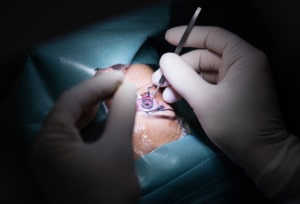
Contact Us Today For A Consultation!
What is pterygium (surfer’s eye)?

Pterygia are non-cancerous growths, but they can cause permanent disfigurement to the eye. They can also be an irritating source of discomfort and can cause your vision to become somewhat blurry.
What causes a pterygium to form?
These growths occur on the conjunctiva, the mucous membrane that covers the white portion (and the cornea) of the eye. It usually is shaped like a wedge, with the wider part of the wedge at the outside of the eye. There isn’t an exact causal link for a person to develop a pterygium, but it is thought that these forms due to too much exposure to the sun’s UV rays. There also seems to be a relationship with windy climates and sand and pollen. Sound like any beaches you know around here?
Risk factors for pterygium
This condition occurs more often in people who live in warm climates and spend lots of time outdoors in sunny, windy environments. These elements in the environment seem to elevate a person’s risk:
Sand
- Smoke
- Wind
- Pollen
Now you can see why pterygium is colloquially known as surfer’s eye.
What are the signs and symptoms of Surfer’s Eye?
Many people with a mild case of pterygium may not experience any symptoms and obviously don’t require treatment. But if you have a large, growing pterygium it will cause a gritty, itchy, or burning sensation in your eye. It will feel as if you have something in your eye (foreign body sensation). As growth becomes inflamed, it will also give you red eyes. Although this is somewhat rare, the growth can invade the cornea and distort the shape of the front surface of the eye, causing astigmatism and other issues that affect your vision.
Does pterygium cause pain?

Can pterygium heal without treatment?
These growths can sometimes gradually start to clear up. But this isn’t the norm. In most people, they grow slowly, particularly if the person tries to block UV exposure and sand and pollen getting in his or her eyes moving forward. They may not be bothered by the small growth on the sclera and opt to leave it be. Still, it’s a good idea to have the team at Maehara keep an eye on these growths, as they become larger and potentially cause problems with the cornea.
One reason to leave a pterygium be is that once removed surgically, they often tend to quickly return.
What People Say About Us!
Dr Jeff is the best and smartest doctor ever!!
Can pterygium cause permanent damage to my eye?
Pterygium that stays on the white of the eye cannot cause any permanent damage to your vision. That’s why it’s a good idea not to do anything about these growths if they are not bothering you. After all, they can often return if they are surgically removed.
But if the growth invades the cornea, then that’s a different situation. Pterygium that reaches the cornea can create scar tissue and this can cause vision loss. These are relatively rare instances, but they merit keeping an eye on the growth and protecting your eyes from UV rays, sand, and pollen as much as possible.
Treatment options for pterygium
If your pterygium is causing irritation or redness, Dr. Maehara will likely start with prescription corticosteroid eye drops or eye ointments. These will reduce inflammation and swelling.
Many patients opt to have these growths surgically removed because they are bothered by the cosmetic appearance of the growth on the white of the eye. If the growth continues, the need may change from cosmetic, as surgery becomes necessary.
How is Pterygium surgery performed?

Using this graft reduces the risk of recurrence dramatically. This used to be a problem with pterygium surgery, as the underlying white was left exposed so it could heal, and recurrence rates approached 50 percent.
Recovery after pterygium surgery
The surgery typically takes just 20-30 minutes. Afterward, you may need to wear an eye patch for one to two days. You’ll have some soreness for the first week following surgery, and there may also be redness for the first couple of weeks. Your eye will return to normal appearance within 2-3 weeks. You can usually return to work and normal activities in a few days.
It’s important to really concentrate on eye protection for the first 12 months after your surgery. Most pterygium regrowth happens during this period. Always wear wraparound sunglasses when outdoors.

 Sand
Sand